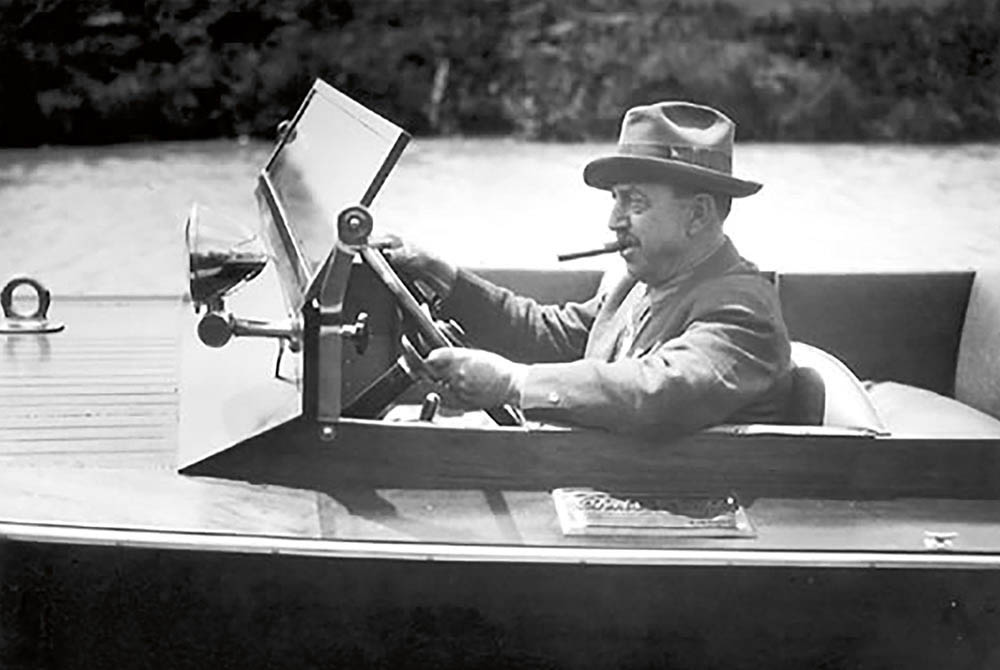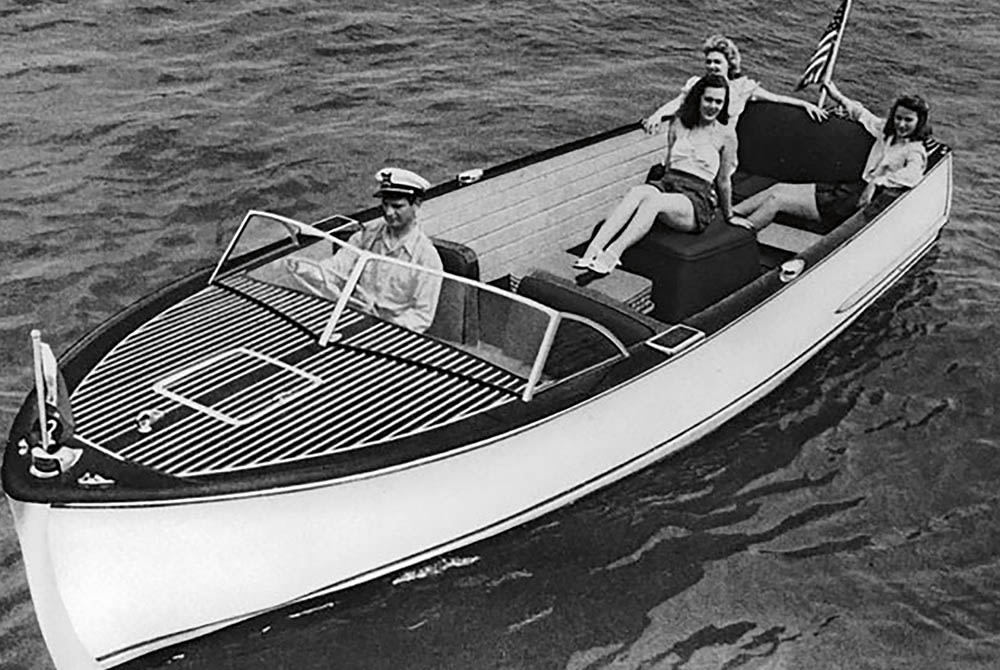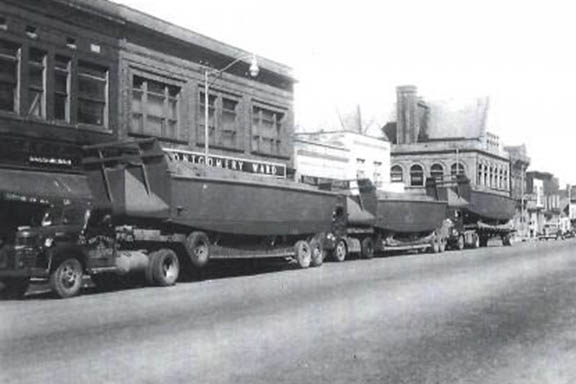The pleasure boat industry is chock full (no pun intended) of the most interesting of people — hard working dedicated individuals and families who put their life savings and full-time energy to fulfilling dreams of creating the boats we know and love. This then are their stories. Many of whom I have met and personally chatted with, and they are unequivocally focused and driven in the pursuit of their dreams.
Part 1 – Christopher Columbus Smith & Chris-Craft
It is appropriate we begin this unveiling of the builders of dreams with a name that is synonymous around the world with pleasure boating – Christopher Columbus Smith (1861-1939). What a beautiful and almost too perfect a name to be associated with a boat builder. He is of course the founder of world-famous Chris-Craft boats.
As a young boy growing up in Algonac, Michigan, Chris Smith, like many boys his age, and with the opportunity right at his doorstep, became smitten with the outdoors, and specifically with duck hunting. You see, Algonac is situated at the northern edge of the delta of the mighty St. Clair River, roughly half way between Sarnia, Ontario and downtown Detroit, where the river empties into shallow Lake St. Clair, which is full of islands and marshes. This was, and still is, a natural habitat for ducks.

Chris was also intrigued with wood, and started carving his own duck decoys, which he also sold to make pocket money. By the age of thirteen, in 1874, utilizing his obvious ingenuity and talented wood skills, he built his own duck hunting boat. It is said this first boat was a 13-foot punt or skiff. Friends and other duck hunters liked what he built, and so young Chris built ones for them too. Over the next few years, he continued to build boats part time to fulfill the growing demand. By 1881, his brother Hank joined him and together they went full time into craftsmanship.
Smith Brothers Boat Builders, as they called themselves, built skiffs, punts, canoes, and rowboats. They also set up a side business supplying ducks to restaurants in the surrounding area, including Detroit. They slowly expanded, and as the boat building business developed moved into a more appropriate riverfront facility. By the turn of the century, Chris became more and more interested in the power available from the ever-improving internal combustion engine. Hank was more the outdoorsman and sportsman, and eventually left boat building to concentrate on his own interests.
Chris renamed the company C.C Smith Boat Builder and put his attention towards going fast on the water. He developed, tested, and refined his own designs in the interest of speed and stability by first-hand carving and testing miniature models before building a full-size boat. In 1905, an Algonac businessman commissioned Chris to build him a race boat. It achieved an unheard of 25 miles per hour! This was the start of a path that would bring widespread recognition and respect to his company and his boats.
With Detroit close by and quickly becoming “The Motor City,” Chris was eager to expand his interest in gasoline engines by learning to tune them to extract more power. He also experimented with the effects of different pitch and diameters of propellers, along with weight distribution and hull design with the objective of obtaining more speed. Wealthy Cincinnati businessman John Ryan commissioned a couple of Chris’ race boats which achieved record-breaking speeds.
In 1910, Ryan invested in the company which then changed its name to the Smith-Ryan Boat Company. With this influx of capital, the company was able to invest in more family-friendly boat designs, and as a result the company grew and prospered. But Chris was still intrigued by race boats and around this time built the first Miss Detroit race boat, which became syndicated and world famous. Chris then went on to win the American Power Boat Association (APBA) Gold Cup of racing in six consecutive years. Industrialist Garfield “Gar” Wood became interested in boat racing, for which he would also become world famous,, and purchased the company following the bowing out of John Ryan.
Chris and his son Jay, who had by then joined his father, stayed on to manage the company for Gar Wood. Racing and race boats brought world-renown and increased sales, but in 1922 Chris and his two sons Jay and Bernard left to rebuild their own family business. They called it Chris Smith & Sons Boat Company and purchased a large chunk of waterfront property in Algonac. They now concentrated on building boats not just for the wealthy but for the new generation of working-class Americans with growing disposable income during the “Roaring Twenties.”
During this period, they also built 33-foot “Baby Gar” boats for Gar Wood under a contract, but this arrangement didn’t last long. Although they built larger and more luxurious models for wealthy clientele such as Henry Ford and William Randolph Hearst, they also specialized in lower priced boats for the middle-class boater. Once again, sales boomed. By the mid-1920s, they were selling over 100 boats per year. Jay, in honour of his father, named a special model the “Chris-Craft” and the name soon stuck. In 1924, the company name was changed to Chris-Craft.
To combat the backlog of orders, and following the lead of the automobile industry, the company was one of the first to institute an assembly line process to streamline production and reduce individual unit costs. Until the mid-1920’s, all sales were factory-direct and the creation of a dealer network took sales to new heights. By the end of the 20s, the factory was producing around 1000 boats per year. Sales were also augmented by a novel (to the boating industry) payment deferral plan. Further efficiencies were gained by the standardization of engine choices from nearby Chrysler Corporation, thus also ensuring a nationwide supply of parts. Sales and profits soared and middle-class Americans were able to enjoy the “good life” that boating offered. In 1927, Chris-Craft claimed to be the world’s largest producer of pleasure boats.

Chris-Craft still sold some opulent models to such notables with last names like Astor, DuPont, Morgan, Wrigley, Firestone, and Vanderbilt. But in order to survive the plunging sales, the focus was to cut costs and strip certain models to the bare essentials to reduce prices. As the 1930s wound down, sales again started to rebound and Chris-Craft started expanding its product line into the growing market of larger cruisers with overnight accommodations. By the end of the decade, it offered almost one hundred different models in its lineup.
By this time, Chris’ son Jay had mostly taken over management of the company and in 1939 arranged the purchase of additional production facilities in Holland, Michigan on the shores of Lake Michigan. In September of that same year, Chris Smith died at the age of 78. The war years saw Chris-Craft devoting much of its production to the war effort, to the extent that it produced almost 13,000 large landing craft for the Navy. To complete this enormous task, Chris-Craft purchased even more production capacity in Cadillac, Michigan in early 1941. All production from this facility had to be shipped by train or trucked to its destination.
The post-war economic boom saw Chris-Craft sales soar once again. By the early 1950s the model lineup was expanding in size, purpose, and price-point, until by the end of the decade it offered over 150 models from 10 production facilities with a total of over 5,000 employees. The 1950s would be the high point of the Chris-Craft prestige and legend. Legends in other fields includiong Katharine Hepburn, Frank Sinatra, Dean Martin, and Elvis Presley became owners of Chris-Craft boats. Chris Smith’s grandson Harsen took over as head of the company. Then, in 1955 Chris-Craft experimented with the building of its first fibreglass boat.

By 1957, Chris-Craft had bought a steel boat maker named Roamer Boat Company. The 43-foot Chris-Craft Steel Roamer became an iconic cruiser, and remains so to this day. A few years later, the Aluminum Company of Canada (Alcan), in its attempt to expand the uses for aluminum, purchased the rights to build the boat in aluminum. You will now find the 43-foot Roamer in both steel and aluminum. In 1960, the Smith family sold Chris-Craft to the NAFI Corporation which changed its name to Chris-Craft Industries.
In 1970, the Algonac, Michigan facility was closed, and in 1971 Chris-Craft built its last wooden boat, a flagship 57-foot double-planked mahogany hull dubbed the Constellation Motor Yacht. In 1981, Chris-Craft Industries sold its boat division to Murray Industries, which also had to purchase a license to the Chris-Craft trademark for use on its boats. It was sold again in 1981 to Outboard Marine Corporation (OMC) which, along with its famed Evinrude and Johnson outboard motors, also offered a full range of sterndrive power and other boat lines. Boat manufacturing moved to a brand new, state-of-the-art facility in Sarasota, Florida.
OMC declared bankruptcy in 2000 and was picked up in 2001 by Genmar Holdings headed by Irwin Jacobs, owner of several recognized boat manufacturers at the time. He almost immediately sold the Chris-Craft portion to Stellican Ltd. headed by British entrepreneur Stephen Julius, the previous owner of Italian luxury boatbuilder, Riva. He and partner Steven Heese then purchased the Chris-Craft trademark from the successor company of Chris-Craft Industries, then owned by Australian media mogul Rupert Murdoch, thus bringing the boat name back together with the boat production company.
Since then, Chris-Craft has concentrated on incorporating vestiges of its legendary designs and materials into the most modern and beautifully crafted luxury sport boats while incorporating the latest in fibreglass technology, hull designs, and only the best available materials. In 2018, Chris-Craft was sold once again, this time to renowned recreational vehicle manufacturer, Winnebago Industries Inc.






